Abstract
Antibiotic concentrations in ascitic fluid after parenteral therapy may be important in the treatment of peritonitis. We have created ascites in dogs by partial ligation of the inferior vena cava. Ascitic fluid volume was measured at the time each antibiotic was administered. Nine antibiotics were studied in the same three dogs. Antibiotic concentration in ascitic fluid was found to vary inversely with ascites volume. Percentage of penetration (ratio of ascites peak to serum peak ×100) ranged from 5.8 to 65% among the drugs studied. Only metronidazole showed a statistically significant higher percentage of penetration than other antimicrobials. Concentrations in ascitic fluid after single doses of cephalothin (15 mg/kg) and the aminoglycosides (2 mg/kg, gentamicin and tobramycin; 7.5 mg/kg, amikacin and kanamycin) did not exceed the minimum inhibitory concentration of many gram-negative rods and may justify the use of higher than usual initial parenteral doses, or possibly initial intraperitoneal administration in seriously ill patients.
Full text
PDF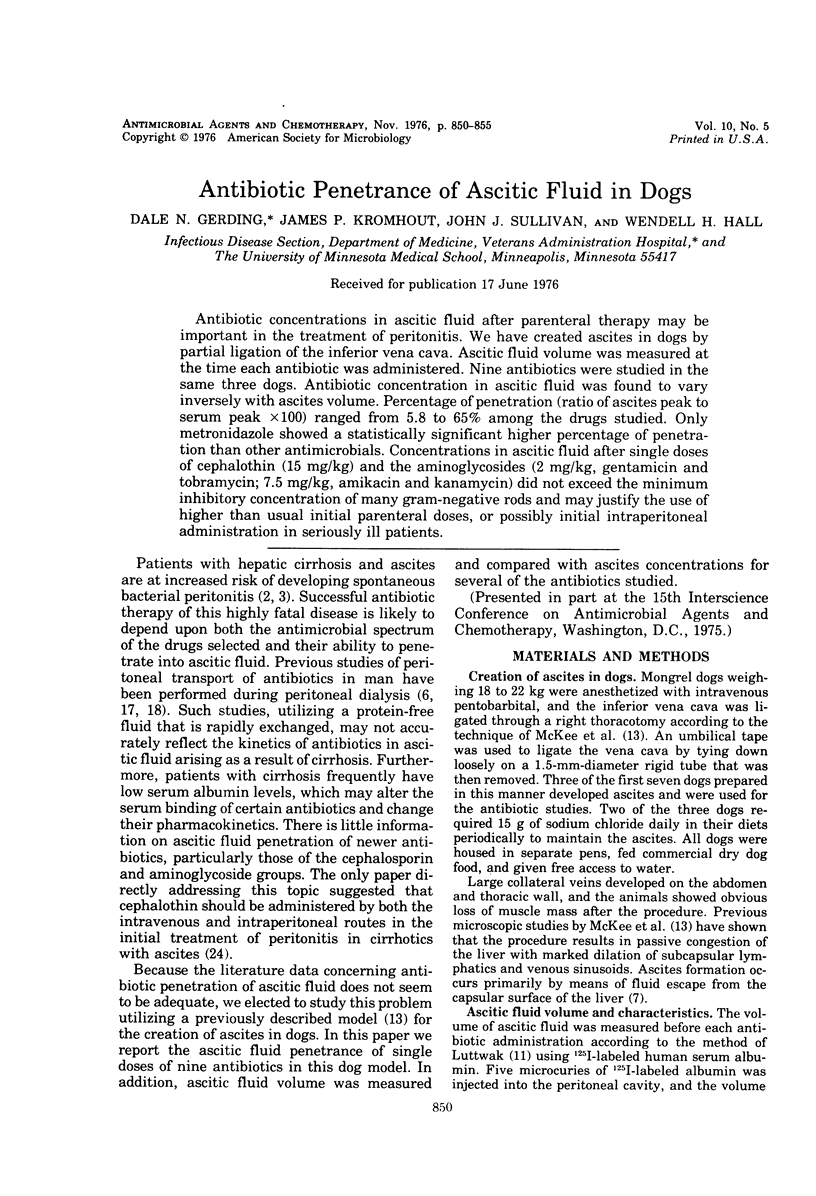
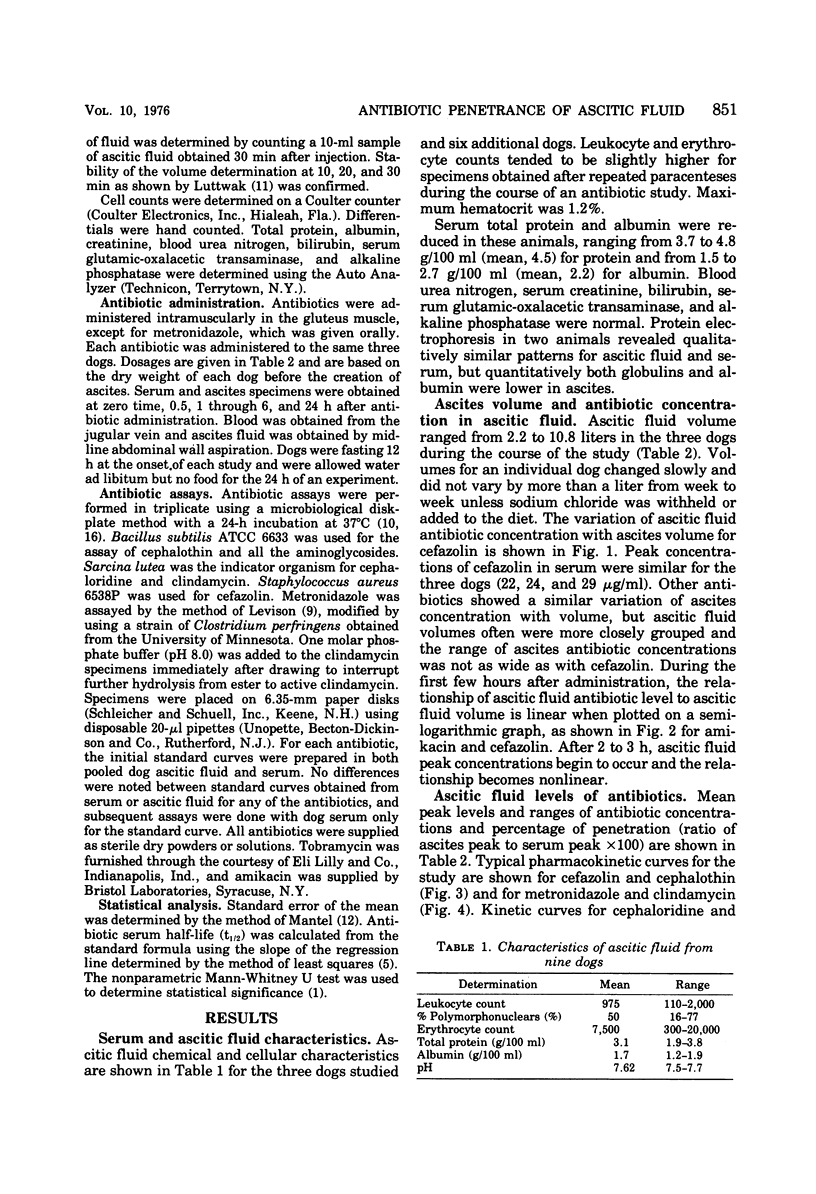
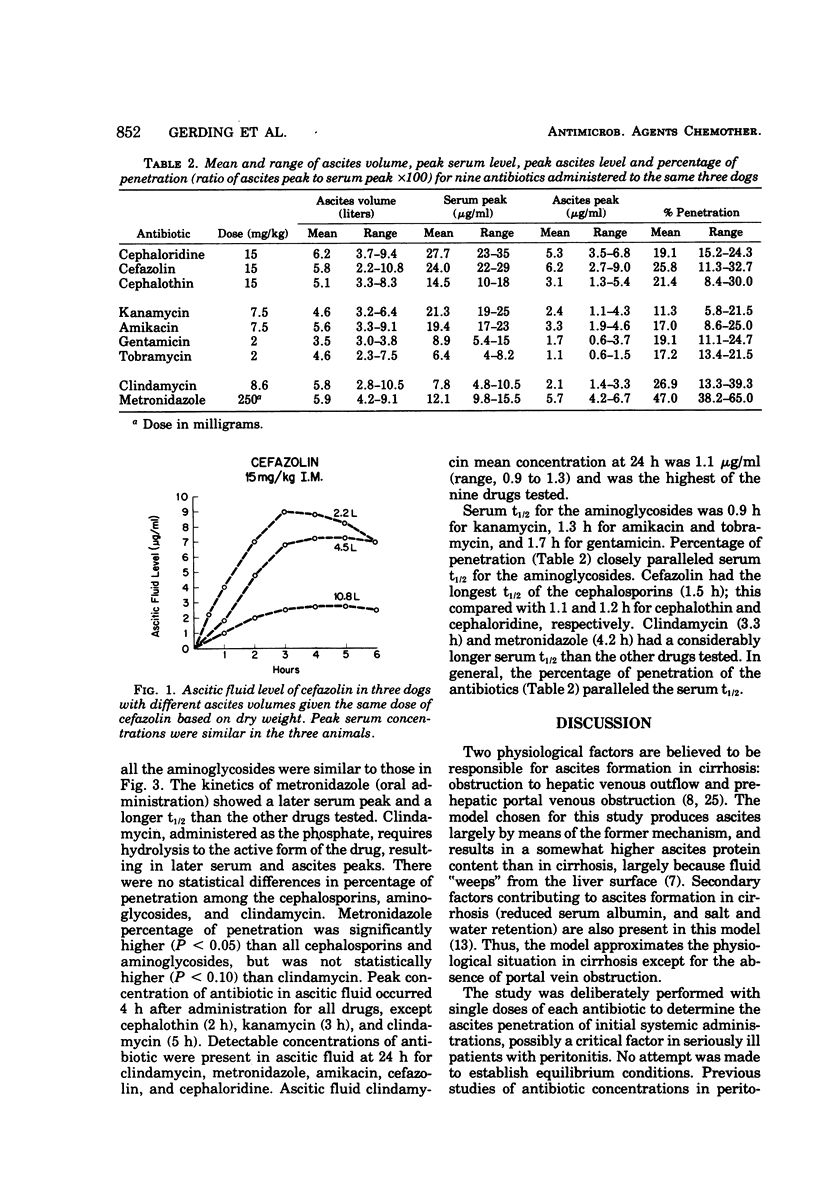
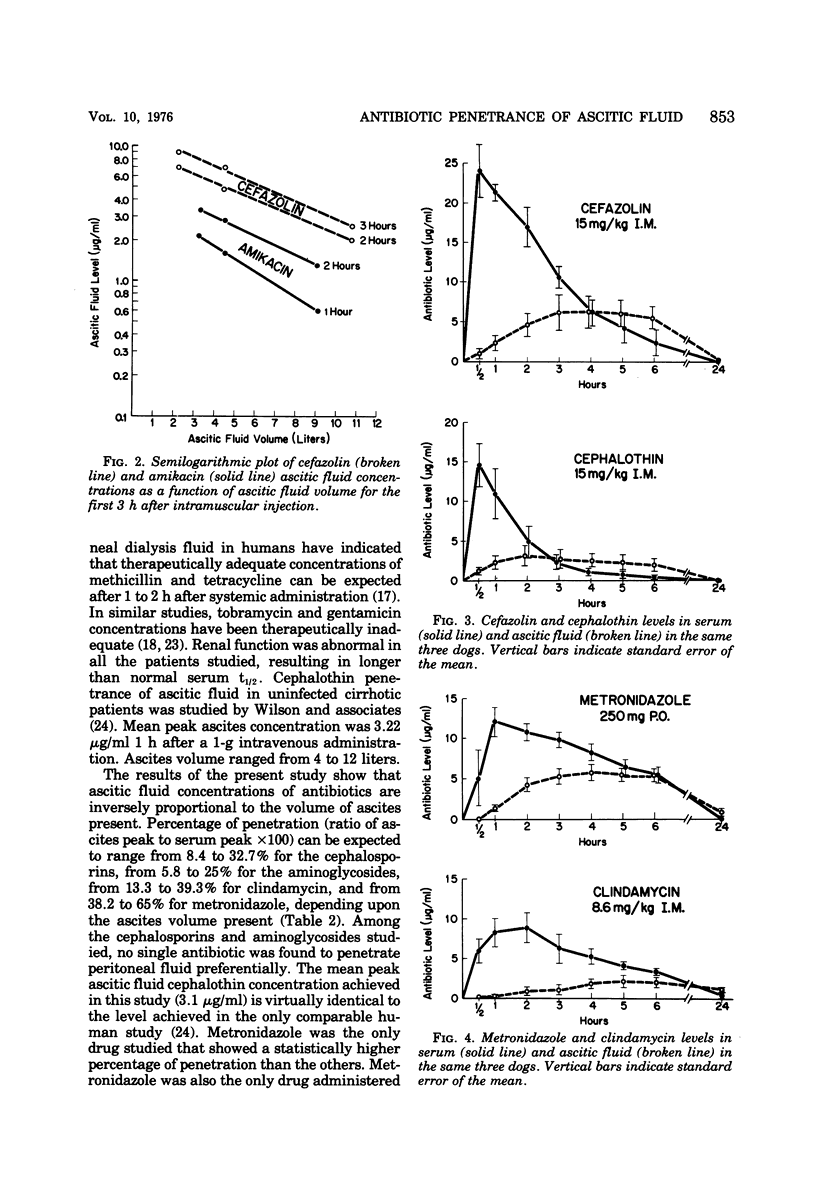

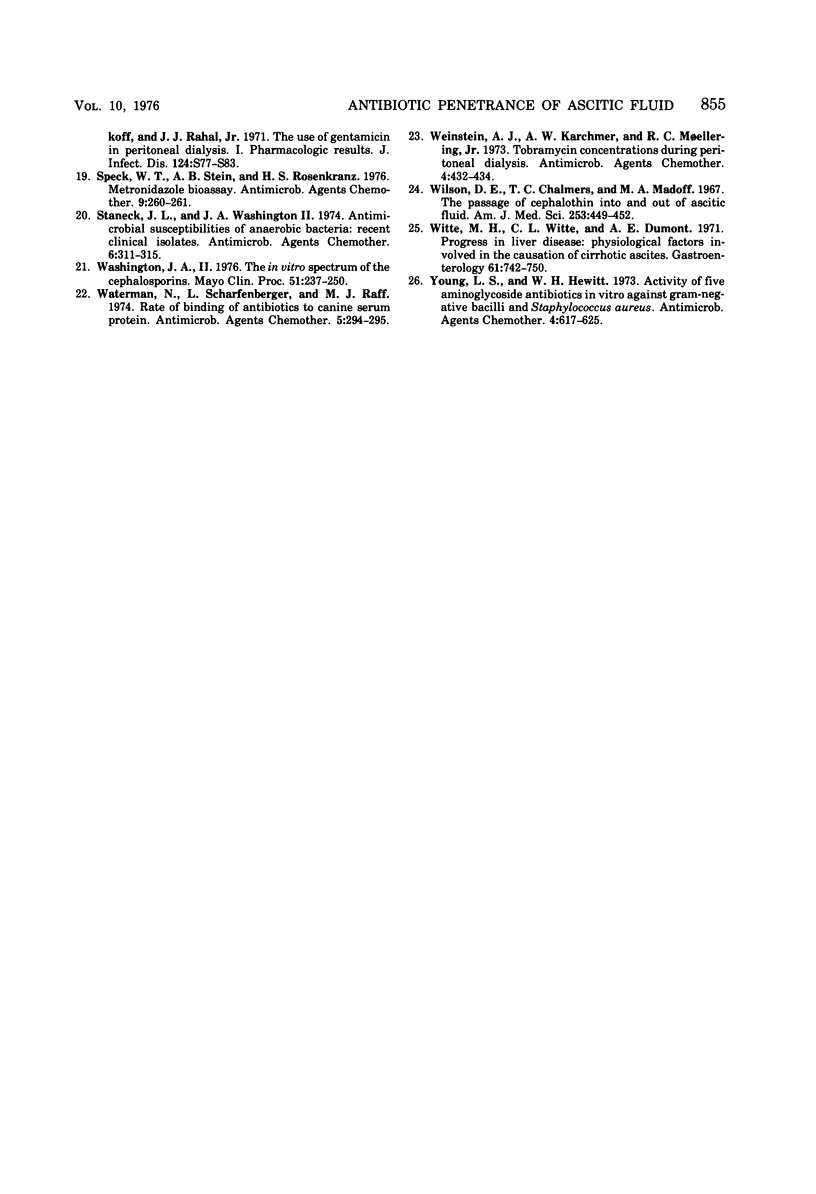
Selected References
These references are in PubMed. This may not be the complete list of references from this article.
- Conn H. O., Fessel J. M. Spontaneous bacterial peritonitis in cirrhosis: variations on a theme. Medicine (Baltimore) 1971 May;50(3):161–197. doi: 10.1097/00005792-197105000-00002. [DOI] [PubMed] [Google Scholar]
- Curry N., McCallum R. W., Guth P. H. Spontaneous peritonitis in cirrhotic ascites. A decade of experience. Am J Dig Dis. 1974 Aug;19(8):685–692. doi: 10.1007/BF01844937. [DOI] [PubMed] [Google Scholar]
- Greenberg P. A., Sanford J. P. Removal and absorption of antibiotics in patients with renal failure undergoing peritoneal dialysis. Tetracycline, chloramphenicol, kanamycin, and colistimethate. Ann Intern Med. 1967 Mar;66(3):465–470. doi: 10.7326/0003-4819-66-3-465. [DOI] [PubMed] [Google Scholar]
- HYATT R. E., LAWRENCE G. H., SMITH J. R. Observations on the origin of ascites from experimental hepatic congestion. J Lab Clin Med. 1955 Feb;45(2):274–280. [PubMed] [Google Scholar]
- HYATT R. E., SMITH J. R. The mechanism of ascites, a physiologic appraisal. Am J Med. 1954 Mar;16(3):434–438. doi: 10.1016/0002-9343(54)90359-9. [DOI] [PubMed] [Google Scholar]
- Levison M. E. Microbiological agar diffusion assay for metronidazole concentrations in serum. Antimicrob Agents Chemother. 1974 May;5(5):466–468. doi: 10.1128/aac.5.5.466. [DOI] [PMC free article] [PubMed] [Google Scholar]
- Luttwak E. M. Quantitative studies of ascitic fluid. Surg Gynecol Obstet. 1973 Feb;136(2):269–272. [PubMed] [Google Scholar]
- Oppenheimer S., Turek M. Laboratory and clinical evaluation of 7-chloro-7-deoxylincomycin. Am J Med Sci. 1968 Nov;256(5):314–321. doi: 10.1097/00000441-196811000-00006. [DOI] [PubMed] [Google Scholar]
- Reynolds A. V., Hamilton-Miller J. M., Brumfitt W. Newer aminoglycosides--amikacin and tobramycin: an in-vitro comparison with kanamycin and gentamicin. Br Med J. 1974 Sep 28;3(5934):778–780. doi: 10.1136/bmj.3.5934.778. [DOI] [PMC free article] [PubMed] [Google Scholar]
- SHEAR L., SHINABERGER J. H., BARRY K. G. PERITONEAL TRANSPORT OF ANTIBIOTICS IN MAN. N Engl J Med. 1965 Apr 1;272:666–669. doi: 10.1056/NEJM196504012721304. [DOI] [PubMed] [Google Scholar]
- Smithivas T., Hyams P. J., Matalon R., Simberkoff M. S., Rahal J. J., Jr The use of gentamicin in peritoneal dialysis. I. Pharmacologic results. J Infect Dis. 1971 Dec;124 (Suppl):S77–S83. doi: 10.1093/infdis/124.supplement_1.s77. [DOI] [PubMed] [Google Scholar]
- Speck W. T., Stein A. B., Rosenkranz H. S. Metronidazole bioassay. Antimicrob Agents Chemother. 1976 Feb;9(2):260–261. doi: 10.1128/aac.9.2.260. [DOI] [PMC free article] [PubMed] [Google Scholar]
- Staneck J. L., Washington J. A., 2nd Antimicrobial susceptibilities of anaerobic bacteria: recent clinical isolates. Antimicrob Agents Chemother. 1974 Sep;6(3):311–315. doi: 10.1128/aac.6.3.311. [DOI] [PMC free article] [PubMed] [Google Scholar]
- Washington J. A. The in vitro spectrum of the cephalosporins. Mayo Clin Proc. 1976 Apr;51(4):237–250. [PubMed] [Google Scholar]
- Waterman N., Scharfenberger L., Raff M. J. Rate of binding of antibiotics to canine serum protein. Antimicrob Agents Chemother. 1974 Mar;5(3):294–295. doi: 10.1128/aac.5.3.294. [DOI] [PMC free article] [PubMed] [Google Scholar]
- Weinstein A. J., Karchmer A. W., Moellering R. C., Jr Tobramycin concentrations during peritoneal dialysis. Antimicrob Agents Chemother. 1973 Oct;4(4):432–434. doi: 10.1128/aac.4.4.432. [DOI] [PMC free article] [PubMed] [Google Scholar]
- Wilson D. E., Chalmers T. C., Madoff M. A. The passage of cephalothin into and out of ascitic fluid. Am J Med Sci. 1967 Apr;253(4):449–452. doi: 10.1097/00000441-196704000-00007. [DOI] [PubMed] [Google Scholar]
- Witte M. H., Witte C. L., Dumont A. E. Progress in liver disease: physiological factors involved in the causation of cirrhotic ascites. Gastroenterology. 1971 Nov;61(5):742–750. [PubMed] [Google Scholar]
- Young L. S., Hewitt W. L. Activity of five aminoglycoside antibiotics in vitro against gram-negative bacilli and Staphylococcus aureus. Antimicrob Agents Chemother. 1973 Dec;4(6):617–625. doi: 10.1128/aac.4.6.617. [DOI] [PMC free article] [PubMed] [Google Scholar]


